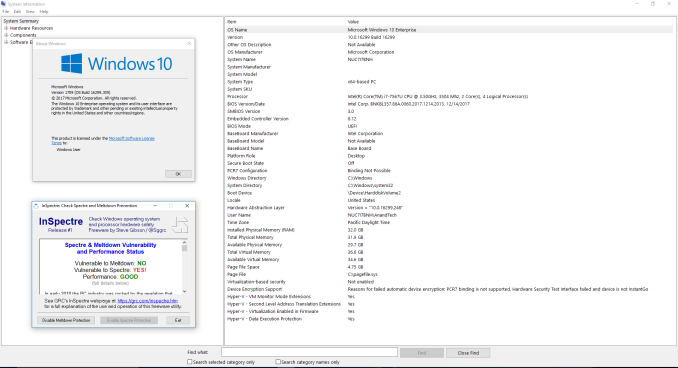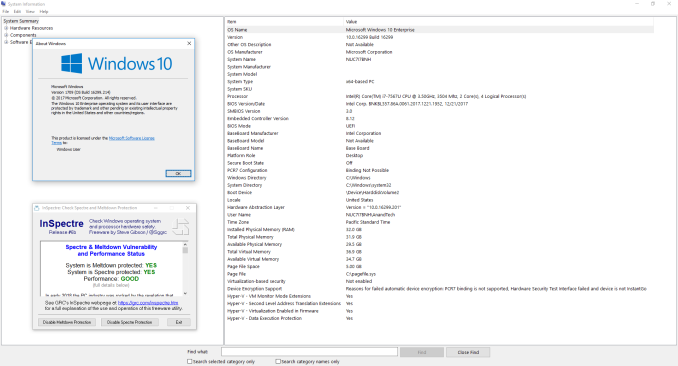Meltdown & Spectre: Analyzing Performance Impacts on Intel's NUC7i7BNH
by Ganesh T S on March 23, 2018 4:15 PM EST- Posted in
- Systems
- Spectre
- Benchmarks
- Meltdown

One of the consequences of the Meltdown and Spectre vulnerabilities, besides the immediate security concerns, is what it has meant for our ongoing testing and benchmarking operations. Along with accounting for the immediate performance changes from the required patches, we've also needed to look at how we present data and how we can (or can't) compare new patched systems to older unpatched systems. From an editorial perspective we need to ensure the continuity of our data as well as providing meaningful benchmark collections.
What we've found so far is that the impact of the Meltdown and Spectre patches varies with the workload and the type of test. Nate's GPU testing shrugs it off almost entirely, while Billy's SSD testing especially feels the pinch. In the middle of course are consumer system reviews, where workloads are more varied but also much more realistic and often more relevant as well. Of course, this is also the type hardware that we most often have to return when we're done, making it the most challenging to correct.
As everyone at AnandTech has been integrating the patches and updating their datasets in their own way, I wanted to offer some insight into what's going on for system testing. With several important systems set to launch in the first half of this year – particularly Intel's Hades Canyon – I've been going back and collecting updated results for use in those future reviews. In the process, I also wanted to document how performance has been impacted by these security patches and which benchmarks in particular have been affected.
Evaluation Setup
The Intel Kaby Lake NUC (NUC7i7BNH) was used for all the benchmarks presented in this article. It was chosen for two reasons. Being a relatively new system that consumers can still purchase in the market, evaluating it presents data of particular relevance to readers. Intel was prompt in providing BIOS updates to resolve the Meltdown and Spectre issues compared to other OEMs whose systems I had in hand for evaluation. The NUC was configured with the following specifications:
| Intel NUC7i7BNH (Unpatched) Specifications | |
| Processor | Intel Core i7-7567U Kaby Lake-U, 2C/4T, 3.5 - 4.0 GHz, 14nm+, 4 MB L2, 28W TDP |
| Memory | Crucial Ballistix Sport LT BLS16G4S240FSD.16FAD DDR4 15-15-15-35 @ 2133 MHz 2x16 GB |
| Graphics | Intel Iris Plus Graphics 650 |
| Disk Drive(s) | ADATA SX8000NP (128 GB; M.2 Type 2280 PCIe 3.0 x4 NVMe; Micron 32L 3D MLC) |
| Networking | Intel Dual Band Wireless-AC 8260 (2x2 802.11ac - 866 Mbps) 1x Intel 10/100/1000 RJ-45 GbE |
| Audio | 3.5mm Headphone Jack Capable of 5.1/7.1 digital output with HD audio bitstreaming (HDMI) |
| Miscellaneous I/O Ports | 4x USB 3.0 Type-A 1x Thunderbolt 3 USB-C 1x micro-SDXC |
| Operating System | Retail unit is barebones, but we installed Windows 10 Enterprise x64 |
| Pricing (Barebones) | USD 445 |
| Full Specifications | Intel NUC7i7BNH Specifications |
Three different patch configurations were benchmarked:
- Completely unpatched
- Only OS patches activated (Graph entry : Patch OS)
- Completely patched with updates to both the OS and the CPU microcode (Graph entry : Patch OS + uCode)
While it will (eventually) be an uncommon configuration, right now a lot of systems are still only running OS patches without their associated microcode updates, as the latter is still being distributed. At the same time, because the microcode patches are primarily for Spectre – Meltdown fixes are implemented at an OS level – this allows us to see just how much of an impact the Spectre fixes have on top of the existing Meltdown fixes.
The completely unpatched system used Windows 10 version 16299.125 with BIOS v0054. As evident from the screenshot below, the system is susceptible to both Spectre and Meltdown.
The second configuration was processed with Windows 10 version 16299.309 with BIOS v0060. The screenshot below shows that the system is protected against Meltdown, but, not Spectre.
The final fully patched configuration was process with Windows 10 version 16299.214 and BIOS v0061. The current BIOS is v0062 (the one we used was available briefly before it was pulled to undergo additional QA for possible random restarts). This configuration shows full protection against both Meltdown and Spectre.
We used our standard test suite for low power desktops / industrial PCs in order to evaluate the impact of the patching on the performance of the system.













83 Comments
View All Comments
rocky12345 - Sunday, March 25, 2018 - link
What I would like to see is for tests done on older cpu's like ivy's and sandy bridge since that is where Intel said the biggest hits in performance would be.Ryan Smith - Monday, March 26, 2018 - link
It's on the list. The microcode is shipping, but we can't actually cover it until either an updated BIOS lands for one of the old mobos we still have, or MS publishes the microcode through Windows Update.CircuitBoard - Sunday, March 25, 2018 - link
Well, looks like storage trend that going to NVMe would be slower than i've expected...piasabird - Sunday, March 25, 2018 - link
It should be illegal for Intel to continue to sell defective parts.HStewart - Sunday, March 25, 2018 - link
Some one purposely creating software virus that effects the security of a system does not mean the system is defected - the real problem here is people that create the virus. That does not mean the system should be updated to prevent such attacks on system in the future.Keep in mind these issues are just on Intel - also on ARM and AMD. And stating that it is illegal for Intel and not including others should complete bias against Intel
mkaibear - Monday, March 26, 2018 - link
It should also be illegal for Ford to sell cars which can go faster than the speed limit. And it should be illegal for Marshall to sell guitar amps which can go loud enough to damage hearing. And it should be illegal for Cisco to sell border routers which can pass traffic to Tor.... Or alternatively we can accept that the problem is people using what is sold for an illegal purpose, like rational humans...
FourEyedGeek - Monday, March 26, 2018 - link
They are not defective, a flaw / exploit has been discovered but they work as intended.Duncan Macdonald - Monday, March 26, 2018 - link
Can you do a similar test on an AMD Ryzen system. I would be interested to see the results there (especially whether Microsoft enables the performance sapping Meltdown fixes on a CPU that does not need them).casperes1996 - Monday, March 26, 2018 - link
Nice read as always. I'd like to suggest a follow-up, looking at how the performance impact is on Linux/macOS, to see if other Ones are hit in the same way as WindowsAdam Slivinsky - Monday, March 26, 2018 - link
Seeing as you are using Steve Gibson's InSpectre tool https://www.grc.com/inspectre.htm in the screen shots, it might be nice mention it and link to it instead of just showing it in the images that spiders can not read.